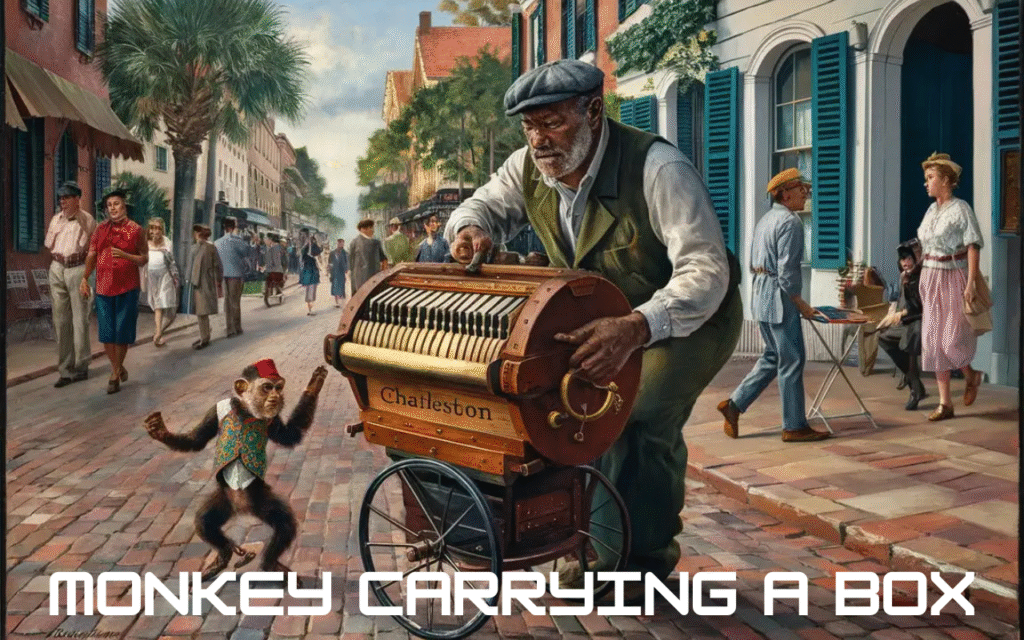The Curious Case of the Monkey Carrying a Box Symbolism, Behavior, and Cultural Significance
Picture this: a monkey trotting along a jungle path, gripping a small, mysterious box. It’s an unusual sight, even in a world filled with curious animal behaviors. This simple yet strange image sparks wonder, amusement, and deeper contemplation. What’s inside the box? Why is the monkey carrying it? Is it a reflection of real-life intelligence, or a metaphor in motion?
The image of a monkey carrying a box captivates audiences for many reasons. It’s quirky, it’s enigmatic, and it’s visually rich with symbolic potential. Whether spotted in a scientific study, viral video, or imagined in a work of fiction, this peculiar behavior leaves a lasting impression. It draws upon our fascination with animals, particularly primates, which often mirror our own habits and emotions in subtle, humorous, and sometimes eerie ways.
This article explores the intriguing intersection of behavior, symbolism, and cultural meaning behind the “monkey carrying a box.” We’ll examine real-world primate behavior, delve into metaphorical interpretations, highlight cultural traditions, and even explore its presence in modern internet culture. By unpacking the layers behind this image, we reveal not only insights about monkeys but also about ourselves. So, let’s open the box—figuratively—and discover what lies within.
Real-World Observations: Do Monkeys Carry Boxes?

In the real world, monkeys have been observed interacting with a wide variety of objects—sticks, stones, leaves, and yes, even boxes. Their curious nature and high intelligence make them excellent problem-solvers and explorers. In several studies, monkeys have used containers to store food or tools, showing early signs of planning and understanding object permanence. This behavioral trait is particularly common among species like capuchin monkeys and chimpanzees, who are known for their dexterity and creative thinking.
Instances of monkeys carrying boxes have even made headlines. In some urban areas, monkeys have adapted to human environments by scavenging through trash bins or stealing lunchboxes. Tourists in places like Bali and India often report encounters with monkeys snatching away purses or plastic containers—sometimes out of mischief, sometimes out of a learned association with food. These real-life interactions showcase how monkeys are not only observant but capable of mimicking human actions when it serves a practical or playful purpose.
Primatologists suggest that the act of carrying a box may be linked to problem-solving behaviors. When a monkey carries a container, it might be exploring its use as a tool, a storage device, or even a toy. In captivity, enrichment activities often include boxes filled with treats or puzzles to stimulate cognitive function. The box becomes more than just an object; it’s a key to understanding how monkeys perceive and manipulate their environment.
Ultimately, the image of a monkey carrying a box isn’t just whimsical—it’s grounded in actual animal behavior. It reflects curiosity, adaptation, and intelligence, providing an authentic glimpse into the complex world of primates.
Symbolic Interpretations: What Could the Box Represent?
Symbolism adds a whole new layer to the image of a monkey carrying a box. In many cultures, the monkey represents mischief, cleverness, or transformation—traits that humans often associate with themselves. The box, in contrast, tends to symbolize mystery, containment, or hidden knowledge. Put them together, and you get a potent metaphor: an intelligent, unpredictable being carrying something secret or sacred.
From a psychological perspective, this image can reflect our inner struggles or hidden emotions. The monkey may represent the impulsive, instinctive side of our minds—our “inner child” or “wild self”—while the box symbolizes repressed thoughts, secrets, or untapped potential. Just like a monkey might curiously peek into a box, we too are often tempted to uncover truths or revisit suppressed memories. The pairing speaks to our natural inclination toward curiosity, even when it leads us into trouble or forces us to confront the unknown.
Artists and storytellers frequently use this imagery in subtle ways. For instance, in modern animation and literature, monkeys carrying objects often symbolize unexpected wisdom or the unraveling of a mystery. The monkey may be seen as a trickster figure, and the box as Pandora’s box—full of consequences once opened. Together, they weave a story that’s both comedic and profound.
In dreams and meditation symbolism, encountering a monkey with a box could signify an impending revelation or the need to look within. It invites introspection and nudges the dreamer to consider what burdens or truths they are carrying—consciously or unconsciously.
Cultural Significance Around the World
Across cultures, monkeys hold powerful symbolic meanings, and when combined with the imagery of a box, the interpretations deepen. In Hindu mythology, Hanuman, the monkey god, is revered for his strength, loyalty, and wisdom. Although he’s rarely depicted with a box, his tales often involve the transportation of sacred items, suggesting that monkeys in these traditions are not merely chaotic creatures but divine messengers.
In Chinese folklore, the Monkey King (Sun Wukong) from Journey to the West is another example of a complex primate figure. Known for carrying magical items and defying the heavens, he represents both rebellion and enlightenment. A monkey with a box could be interpreted as a modern echo of these traditional tales—carrying wisdom, mischief, and potential in a single image.
Meanwhile, Japanese culture honors monkeys as mediators between gods and humans. The famous “See No Evil, Hear No Evil, Speak No Evil” monkeys originate here, symbolizing ethical behavior. A monkey carrying a box in this context might represent a burden of responsibility or a vessel of moral truth.
In African and Caribbean folklore, monkeys are often trickster figures. The idea of one carrying a box could be seen as carrying secrets, mischief, or tools of transformation. These interpretations reflect a shared human fascination with animals that walk the line between the natural and supernatural worlds.
Overall, the “monkey carrying a box” motif resonates differently depending on cultural context—but almost always retains a sense of magic, meaning, and deeper significance.
Modern Representations in Media and Internet Cultur
In the digital age, few images travel faster than a humorous animal video. Monkeys, with their expressive faces and human-like behavior, are internet gold. A monkey carrying a box, especially in a human-like fashion, often goes viral due to its blend of absurdity and relatability. These images and videos elicit laughter but also spark deeper conversations about animal intelligence and our own projection of human traits onto animals.
In popular media, this imagery has appeared in various animated series, advertisements, and even video games. Characters resembling monkeys carrying mysterious containers are often portrayed as quirky, clever, or mischievous. In games like Donkey Kong or animated films like Madagascar, monkeys are frequently depicted with gadgets, crates, or magical items—each reinforcing the archetype of the monkey as a carrier of unexpected surprises.
Memes have also embraced this concept. Online users interpret the image in creative ways: the monkey carrying “emotional baggage,” a metaphor for “life responsibilities,” or even a humorous caption like “When you’re holding onto drama you didn’t ask for.” These interpretations keep the image alive and relevant, transforming it into a cultural symbol that shifts with context.
The popularity of this imagery underscores a key point: we’re naturally drawn to visual metaphors. A monkey carrying a box isn’t just an animal doing something unusual—it becomes a mirror to our own lives, full of responsibilities, secrets, and curiosity.
Conclusion
The image of a monkey carrying a box might seem amusing or insignificant at first glance, but it is packed—much like the box itself—with meaning. From real-life observations in the wild to symbolic interpretations in dreams, art, and culture, this simple act reveals complex layers of behavior and thought. Monkeys, intelligent and expressive, offer a fascinating lens into both the animal kingdom and our own psyche.
Culturally, the combination of monkey and box appears in various forms—from divine symbolism in Hindu and Chinese traditions to internet memes filled with wit and emotional resonance. This imagery taps into universal themes: curiosity, mystery, burden, and discovery. It reflects how we assign meaning to the world around us, especially when we see a part of ourselves in the animals we observe.
Whether interpreted through science, symbolism, or storytelling, the monkey carrying a box remains a powerful visual metaphor. It reminds us to stay curious, to embrace mystery, and to understand that even the smallest actions can carry the weight of great meaning.
FAQs
Do monkeys naturally carry objects like boxes in the wild?
Yes, monkeys often carry and manipulate objects such as boxes, containers, or tools in both the wild and captivity. Their behavior shows high intelligence and curiosity.
What does a monkey carrying a box symbolize in dreams?
In dreams, this imagery often symbolizes hidden truths, emotional burdens, or a call to explore repressed thoughts and ideas.
Has this image been used in any famous artwork or film?
While not always literal, similar themes appear in films, animations, and video games featuring monkeys with mysterious items or tools.
Are there any psychological interpretations of monkeys carrying things?
Psychologists may interpret this as symbolic of the human mind grappling with secrets, curiosity, or the weight of responsibility.
Why is the combination of monkey and box so popular online?
It’s a mix of humor and relatability. The imagery lends itself to memes and symbolic captions, making it easy to connect with emotionally and cultur
You May Also Read: https://otswroldtime.com/unblocked-66-ez/













Post Comment